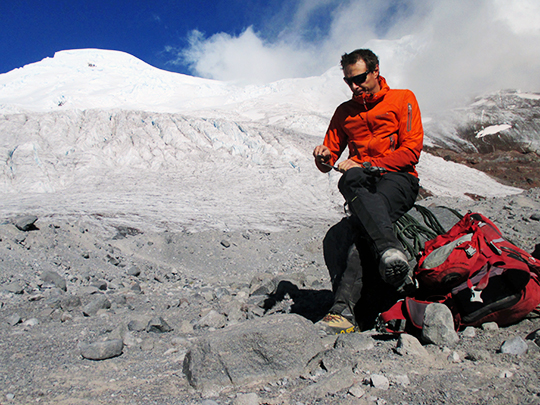[Photo] Austin Gibney
This year I put my new pair of Electric Tech One sunglasses through rigorous field-testing. I wore them on a month-long climbing trip to Colorado’s Front Range, the Moab area and northern Arizona. I also used them while backcountry skiing in Rocky Mountain National Park and guiding clients up glaciers on Antisana, an 18,714-foot peak in Ecuador.
Sunglasses, although often overlooked as climbing gear, are essential mountain tools used for our adventure and climbing goals. As a long-time alpine guide, I bring sunglasses on every trip, giving me a wide variety of experiences from good to bad.
Before buying a new pair of sunglasses, I follow a handful of important criteria: style, fit and coverage, lens quality, fit under a helmet, ear frames that don’t scratch the lens, and durability.
Style: The Tech One sunglasses aren’t sexy; they don’t come in bright colors like lime green, fire-engine red, or sky blue. Though I usually look for flashy sunglass frames because they look great in photos, the Tech One’s black frames are slick and cool.
Fit/Coverage: I have a small head but they never fell off my face and they gave good coverage on my cheeks and around my temples. I gave a second pair of Tech Ones to another guide in Ecuador and they also fit his larger head without slippage, proving the versatility of their fit.

[Photo] Austin Gibney
Lens Quality: I used Tech Ones with level II (M2) polarized lenses. Sometimes when I was rock climbing, they were a bit too dark to make visual transitions from sun to shade. They, however, were perfect sunglasses for single-day glacier climbing, ice climbing and skiing. The non-scratch lens surface is also perfect. When I folded the frames to store them in a pack or pocket, the tips didn’t rub against the inside lens surface.
Helmet Fit: The glasses offer a perfect fit with helmets. The pointed ear frames slipped into my helmet with little effort and stayed in place when I looked down. A bit of rubber on the ends of the frames would also keep them from slipping off when I propped them on a hat or beanie.
Durability: The sunglasses are durable, with flexible frames and lenses. They bend either outward or inward without snapping or breaking.
After using the Electric Tech One sunglasses, I recommend them as a great addition to your climbing kit. The few minimal problems I experienced were a slight fogging problem on the Antisana summit day, specifically when I wore a Buff over my nose to avoid frost-nip, and scratches after cleaning them with the provided storage bag. The second problem could have been because I was climbing in the desert and sand may have blown into the pouch.

[Photo] Makena Christison
Pros: Flexibility to fit a variety of head sizes; fits well under a helmet; no coverage gaps on the cheeks and temples; frames don’t scratch lenses when folded in; durable; great for single-day snow/glacier climbing and skiing.
Cons: Plain black frame style; no rubber on frames to help keep sunglasses propped on beanie or sun hat; not dark enough for multi-day glacier expeditions.
Mike Lewis, M.A. is an AMGA Certified Rock and Alpine Guide living in Estes Park, CO. Mike has been guiding and instructing for 22 years throughout the U.S. and internationally. Learn more about Mike at LunchboxJackson.com.